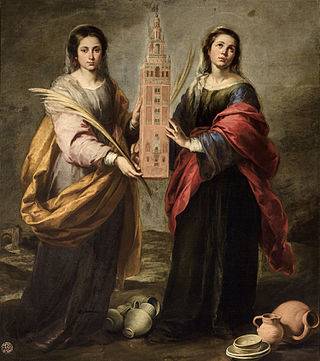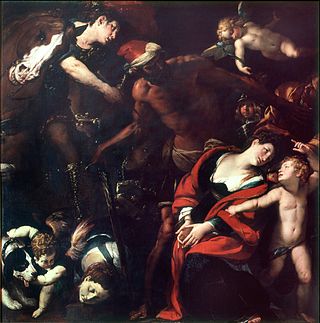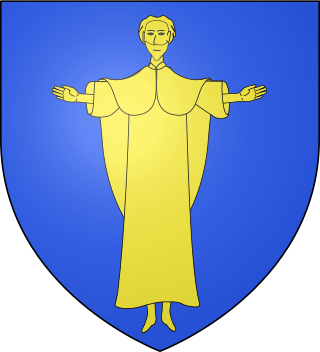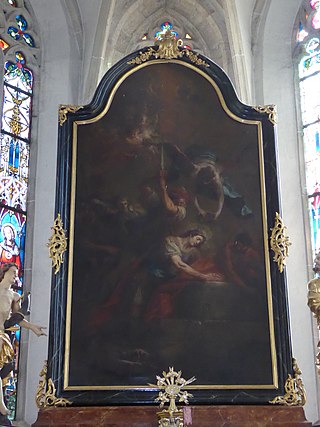Related Research Articles

Agnes of Rome is a virgin martyr, venerated as a saint in the Catholic Church, Oriental Orthodox Church and the Eastern Orthodox Church, as well as the Anglican Communion and Lutheran Churches. She is one of several virgin martyrs commemorated by name in the Canon of the Mass, and one of many Christians martyred during the reign of the Roman emperor Diocletian.

Pope Marcellinus was the bishop of Rome from 30 June 296 to his death in 304. A historical accusation was levelled at him by some sources to the effect that he might have renounced Christianity during Emperor Diocletian's persecution of Christians before repenting afterwards, which would explain why he is omitted from lists of martyrs. The accusation is rejected, among others, by Augustine of Hippo. He is today venerated as a saint in the Catholic Church and in the Serbian Orthodox Church.

Cassian, or Saint Cassian of Imola, or Cassius was a Christian saint of the 4th century. His feast day is August 13.

Prisca was a young Roman woman allegedly tortured and executed for her Christian faith. The dates of her birth and death are unknown. She is revered as a saint and martyr in Eastern Orthodoxy, by the Catholic Church, and in the Anglican Communion.

Vitalis of Milan was an early Christian martyr and saint.
Saints Marius, Martha, Audifax, and Abachum were, according to their largely legendary passio of the 6th century, four saints of the same family. They came from Persia to Rome, and were martyred in 270 for sympathizing with Christian martyrs and burying their bodies. Some ancient martyrologies place the date of their death between 268 and 270, during the reign of Claudius II, although there was no persecution of Christians during this time.

The Martyrology of Usuard is a work by Usuard, a monk of the Benedictine abbey of Saint-Germain-des-Prés. The prologue is dedicated to Charles the Bald indicating that it was undertaken at that monarch's instigation. It was apparently written shortly before the author's death in 875. The martyrology enjoyed consistent success throughout the Middle Ages, as evidenced by numerous surviving manuscripts. This martyrology synthesizes elements of the old Martyrologium Hieronymianum, the martyrology of Ado of Vienne, and an enhanced version of that of Bede, attributed to the archdeacon Florus of Lyon. It contains eleven hundred saints' lives. The martyrology is a compilation upon which the later Roman Martyrology depended closely until the twentieth century; it remained throughout the Middle Ages the most famous document of its kind. It is preserved to us in innumerable manuscripts, of which Henri Quentin gives a partial list.

Martina of Rome, a patron saint of Rome, was martyred in 226, according to some authorities, more probably in 228, under the pontificate of Pope Urban I, according to others. Her feast day is 30 January.

Jovita and Faustinus were said to be Christian martyrs under Hadrian. Their traditional date of death is 120. They are patron saints of Brescia. Faustinus is the patron saint of Pietradefusi.

Andronicus, Probus and Tarachus were martyrs of the Diocletian persecution. According to tradition, Tarachus was beaten with stones. Probus was thrashed with whips, his back and sides were pierced with heated spits; finally he also was cut up with knives. Andronicus was also cut to pieces with knives.

Martinian and Processus were Christian martyrs of ancient Rome. Neither the years they lived nor the circumstances of their deaths are known. They are currently buried in St. Peter's Basilica in Rome.

Saints Primus and Felician (Felicianus) (Italian: Primo e Feliciano) were brothers who suffered martyrdom about the year 304 during the Diocletian persecution. The Martyrologium Hieronymianum gives under June 9 the names of Primus and Felician who were buried at the fourteenth milestone of the Via Nomentana (near Nomentum, now Mentana).

Romanus of Caesarea, also known as Romanus of Antioch, is venerated as a martyr. A deacon of Caesarea, he was martyred at Antioch.
There are several saints named Rufus, of which the Roman Martyrology records ten; historical mention is made of the following ones, which have liturgical feasts:
- On 19 April, a group of martyrs in Melitene in Armenia, one of whom bears the name of Rufus. These martyrs are mentioned already in the Martyrologium Hieronymianum.
- On 1 August, Rufus, with several companions who, according to the most reliable manuscripts of the "Martyrologium Hieronymianum" died at Tomi, the place being afterwards by mistake changed to Philadelphia.
- On 27 August, two martyrs named Rufus at Capua -- one, whose name also appears as Rufinus in the "Martyrologium Hieronymianum". The other is said to have suffered with a companion, Carpophorus, in Diocletian's persecution circa 304 AD.
- On 25 September, several martyrs at Damascus, among them one named Rufus.
- On 7 November, a Rufus of Metz, who is said to have been Bishop of Metz; his history, however, is legendary. His name was inserted at a later date in an old manuscript of the "Martyrologium Hieronymianum"(ed. cit., 140). In the ninth century his relics were transferred to Gau-Odernheim in Hesse, Diocese of Mainz.
- On 12 November, Rufus, legend, without any historical proof, the supposed first Bishop of Avignon, who is perhaps identical with Rufus, the disciple of Paul.
- On 21 November, Rufus the disciple of the Apostles, who lived at Rome and to whom Saint Paul sent a greeting, as well as he did also to the mother of Rufus. St. Mark says in his Gospel that Simon of Cyrene was the father of Rufus, and as Mark wrote his Gospel for the Roman Christians, this Rufus is probably the same as the one to whom Paul sent a salutation.
- On 28 November, a Roman martyr Rufus, probably identical with the Rufinianus who was buried in the Catacomb of Generosa on the Via Portuensis, and who is introduced in the legendary Acts of the martyrdom of St. Chrysogonus.
- On 18 December, the holy martyrs Rufus and Zosimus, who were taken to Rome with St. Ignatius of Antioch and were put to death there for their unwavering confession of Christianity during the persecution of Trajan. St. Polycarp speaks of them in his letter to the Philippians.

Saints Justa and Rufina (Ruffina) (Spanish: Santa Justa y Santa Rufina) are venerated as martyrs. They are said to have been martyred at Hispalis (Seville) during the 3rd century.

Saints Emeterius and Celedonius are venerated as saints by the Catholic Church. Two Roman legionaries, they were martyred for their faith around 300. They are patron saints of Calahorra, which is traditionally regarded as the place of their death.

Rufina and Secunda were Roman virgin-martyrs and Christian saints. Their feast day is celebrated on 10 July.

Andeolus or Andéol is an alleged Christian missionary martyred in Gaul.
Marcellus and Apuleius were third- or fourth-century martyrs who were inserted in the General Roman Calendar in the 13th century. They were recognized as saints by the Catholic Church, with 7 October as their feast day. Apuleius is considered purely legendary, and is no longer recognized.

Quirinus of Tegernsee, or Quirinus of Rome, is venerated as a martyr and saint of the third century.
References
- ↑ "St Nicomedes", The Concise Oxford Dictionary of the Christian Church, 2nd ed. (E. A. Livingstone, ed.) OUP, 2013 ISBN 9780198614425
- 1 2 3 Kirsch, Johann Peter. "St. Nicomedes." The Catholic Encyclopedia Vol. 11. New York: Robert Appleton Company, 1911. 19 November 2021
 This article incorporates text from this source, which is in the public domain .
This article incorporates text from this source, which is in the public domain . - ↑ Monks of Ramsgate. "Nicomedes". Book of Saints 1921. CatholicSaints.Info. 26 March 2016
 This article incorporates text from this source, which is in the public domain .
This article incorporates text from this source, which is in the public domain . - ↑ Butler, Alban. "Saint Nicomedes, Martyr". Lives of the Fathers, Martyrs, and Principal Saints 1866. CatholicSaints.Info. 15 September 2013
 This article incorporates text from this source, which is in the public domain .
This article incorporates text from this source, which is in the public domain .
![]() This article incorporates text from a publication now in the public domain : Herbermann, Charles, ed. (1913). "Saint Nicomedes". Catholic Encyclopedia . New York: Robert Appleton Company.
This article incorporates text from a publication now in the public domain : Herbermann, Charles, ed. (1913). "Saint Nicomedes". Catholic Encyclopedia . New York: Robert Appleton Company.